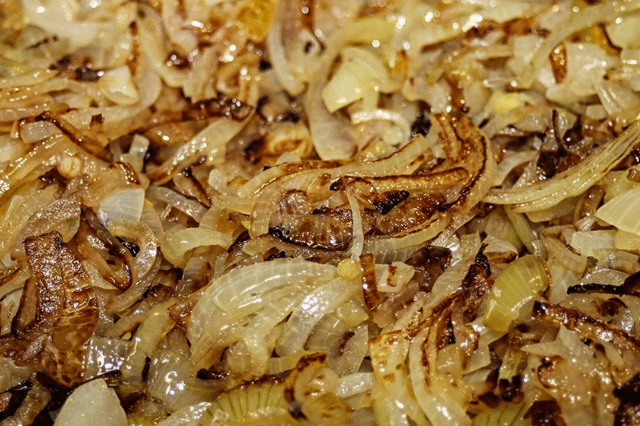
An onion, particularly a yellow or Bermuda onion possesses a strong, perhaps acrid flavor. And its aroma? You are likely to weep when you chop one! Yet, if you take that same onion and fry it, it can be just as fragrant and sweet as ever you could wish. What happened? It’s a matter of chemistry.
From Wild to Tame
The flavor of a raw onion is the product of a number of complex organic substances. The ingredient primarily responsible for tear-ing, is (Z)-propanethial-S-oxide. This compound, a lachrymator (tear-producing gas), is produced when onion cell walls are broken by slicing and chopping. Does frying result in a decrease of this chemical, resulting in sweetness? Does this compound decompose on frying to producing the sweetness?1
Frying does, indeed, lower the quantity of PSO in the onion, converting it to 3-Mercapto-2-methylpentan-1-ol (MMP). But although the raw onion flavor diminishes as a result, the conversion imparts a savory, meaty flavor. We must look elsewhere to explain the increased sweetness.
From Heat to Sweet
When it comes to increasing sweetness by means of cooking – say in a skillet on the top of a stove – there apparently are a number of factors involved. The temperature and the time involved are two essential factors. Slow simmering onions makes them translucent and builds sweetness. Cooking onions at a higher heat, in the presence of oil especially, invokes caramelization. And since onions cook down to a fraction of their original volume, flavor, including sweetness too, increases.
Part of the increased sweetness is due to the lowering of the other flavor components. If your toe is not hit with a hammer, you are inclined to think of your sore throat.
Part of the flavor change when cooking onions involves the breakdown of sulfur-containing compounds in the onions. Precisely how they break down and what the changes are depends on many factors. One variety of sulfur-free compound, polysaccharides, is broken down by heat into smaller monosaccharides. Imagine a string of beads being broken into smaller strings of beads, and eventually individual beads. Although one “string” may seem sweet, many shorter strings are sweeter!
Summing Up
Doubtless, a consideration of the onion helps us better understand the complex interactions and changes that result from the cooking process. We come to better appreciate how cooking still remains more an art than a science. Still, many a scientist dabbles in the art of cooking. Don’t expect him to stop trying to convert it into a science.
1 It should be kept in mind that different cultivars of onion contain varying initial levels of flavor-causing compounds, including some sugars. Not all the sweetness of every onion is caused by the heating process.
Note: You may also enjoy Cooked Blueberries Taste Different – Why?
References:
- Chopping Onions Makes You Cry
- The Science of Onion Flavor
- Journal of Agricultural and Food Chemistry: 3-Mercapto-2-methylpentan-1-ol, A New Powerful Aroma Compound
- Utah State University Extension: Viva Onions
- kitchn: Raw to Sweet: How to Change the Intensity of Onions
← Back to Food and Health
← Home